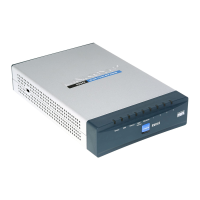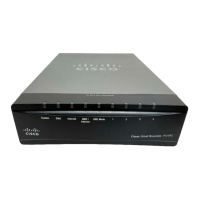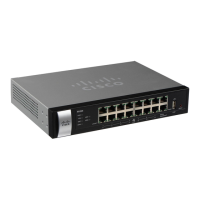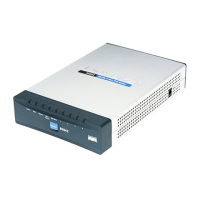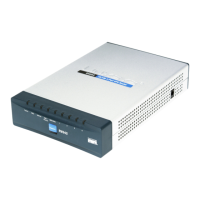
Do you have a question about the Cisco RV082 - Small Business VPN Router and is the answer not in the manual?
| VPN Tunnels | 50 |
|---|---|
| DHCP Server | Yes |
| Authentication | MD5, SHA1 |
| Power Supply | 12V DC, 1A |
| Humidity | 10% to 85% non-condensing |
| LAN Ports | 8 x 10/100 Mbps RJ-45 |
| VPN Protocols | IPSec, PPTP, L2TP |
| Firewall | SPI |
| Encryption | DES, 3DES, AES |
| Memory | 8 MB Flash, 32 MB DRAM |
| Operating Temperature | 0 to 40°C |
| Storage Temperature | -4 to 158°F (-20 to 70°C) |
| Weight | 0.69 kg |
Details on the features of the Cisco RV0xx Series dual WAN VPN routers.
Guidance on how to install and place the router for optimal operation.
Instructions for physically connecting network devices to the router.
Steps to initially set up and access the router's configuration interface.
Overview of the router's graphical user interface elements and navigation.
Configuration of LAN, WAN, and DMZ settings, including host and domain names.
Choosing between IPv4-only or Dual-Stack IP addressing for the network.
Configuring the router's LAN IP address and enabling multiple subnets.
Setting up the router's connection to the Internet, including connection types.
Configuring the DMZ port to allow specific hosts public Internet access.
Securing the router by changing default login credentials for administrative access.
Configuring the router's system time using NTP or manual settings.
Allowing a single host on the LAN to be exposed to the Internet via DMZ.
Configuring rules to allow external access to internal services or applications.
Enabling automatic port configuration for Internet applications like gaming.
Mapping external IP addresses to internal IP addresses for direct resource access.
Registering a specific MAC address with the ISP for WAN connection.
Configuring DDNS to access the router via a domain name with a dynamic IP.
Configuring dynamic and static routing tables for network traffic management.
Enabling and configuring 6to4 tunnels for IPv6 packet routing.
Configuring the router as a DHCP server or relay agent for IP address assignment.
Enabling RADVD for IPv6 auto-configuration and routing on the network.
Configuring multiple WAN connections for backup or load balancing.
Adjusting bandwidth for upstream/downstream traffic and QoS for services.
Resetting the router to its original factory default configuration and settings.
Downloading and installing the latest firmware to update router functionality.
Saving and restoring router configuration files for backup and recovery.
Customizing port priority, speed, duplex mode, and VLAN settings.
Monitoring port status, link status, activity, and statistics.
Enabling/disabling firewall, SPI, DoS, and restricting web features like Java/Cookies.
Creating and managing rules to control network traffic allowed through the firewall.
Blocking access to specified websites or keywords based on domains and schedules.
Steps to purchase, register, and activate the Cisco ProtectLink Web security service.
Configuring lists of approved URLs and clients that bypass web protection restrictions.
Configuring URL filtering categories and web reputation settings for website access control.
Understanding Virtual Private Networks and their application in secure remote access.
Displaying overview of VPN tunnel status, usage, and client connections.
Configuring VPN tunnels for secure site-to-site network connections.
Establishing VPN tunnels for individual users to access the network remotely.
Enabling or disabling support for various VPN protocols passing through the router.
Configuring the router to act as a PPTP VPN server for remote client access.
Configuring syslog and email alerts for network events and security incidents.
Displaying port statistics, traffic counts, and error information for network interfaces.
Using the wizard to configure WAN ports and the Internet connection.
Using the wizard to create firewall access rules for network security.
Steps to resolve issues when the router's firmware upgrade process fails.
Troubleshooting steps to diagnose and fix internet connectivity problems for the computer.
Overview of Cisco QuickVPN client software for secure remote VPN access.
Steps to download, install, and configure the Cisco QuickVPN client software.
Instructions on how to connect and manage VPN tunnels using the QuickVPN client.
Considerations for choosing between hub-and-spoke or mesh VPN topologies.
Step-by-step guide for setting up a VPN tunnel on the Cisco RV0xx Series router.
Explanation of NAT traversal technique for IPSec data to pass through NAT.
Steps to configure IPSec NAT traversal settings on the initiator router (Router A).
Steps to configure IPSec NAT traversal settings on the responder router (Router B).
Defining new services, like VoIP, for bandwidth management rules.
Setting up rules to control upstream and downstream bandwidth for specific services.
Detailed technical specifications for the Cisco RV042 router model.
Detailed technical specifications for the Cisco RV042G router model.
Detailed technical specifications for the Cisco RV082 router model.
Detailed technical specifications for the Cisco RV016 router model.
Resources for Cisco Small Business support, community, and firmware downloads.
Links to Cisco Small Business Routers documentation for further reading.
Information and resources for Cisco Small Business partners and home users.
